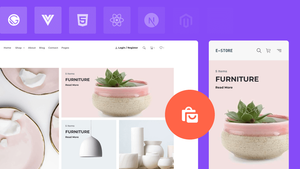Customers' purchasing habits have significantly changed in the past decade. While people were once wary of buying goods online, they have now started to embrace eCommerce. According to research, almost 60% of internet users make a purchase online every week.
eCommerce sites are a big thing now. They accounted for 18% of all retail sales in 2020. Mobile and social eCommerce introduced new revenue streams to companies, further expanding the industry.
However, customers' expectations remain the same regardless of how they shop. They want a personalized and pleasant shopping experience. How can online stores meet consumers’ expectations?
They can turn to headless eCommerce. This technology allows them to improve user experience and deliver content to all channels and devices customers use.
Platforms like TeleportHQ enable you to offer great shopping experiences without any constraints. You can create headless static websites with TeleportHQ for higher personalization and speed. Start now by creating your free account!
In today’s article, we’ll go deeper into headless eCommerce to help you understand the benefits of such technology. We will also list the five best tools you can use for your project. Let's start with some basic information about headless eCommerce.
What is headless eCommerce?
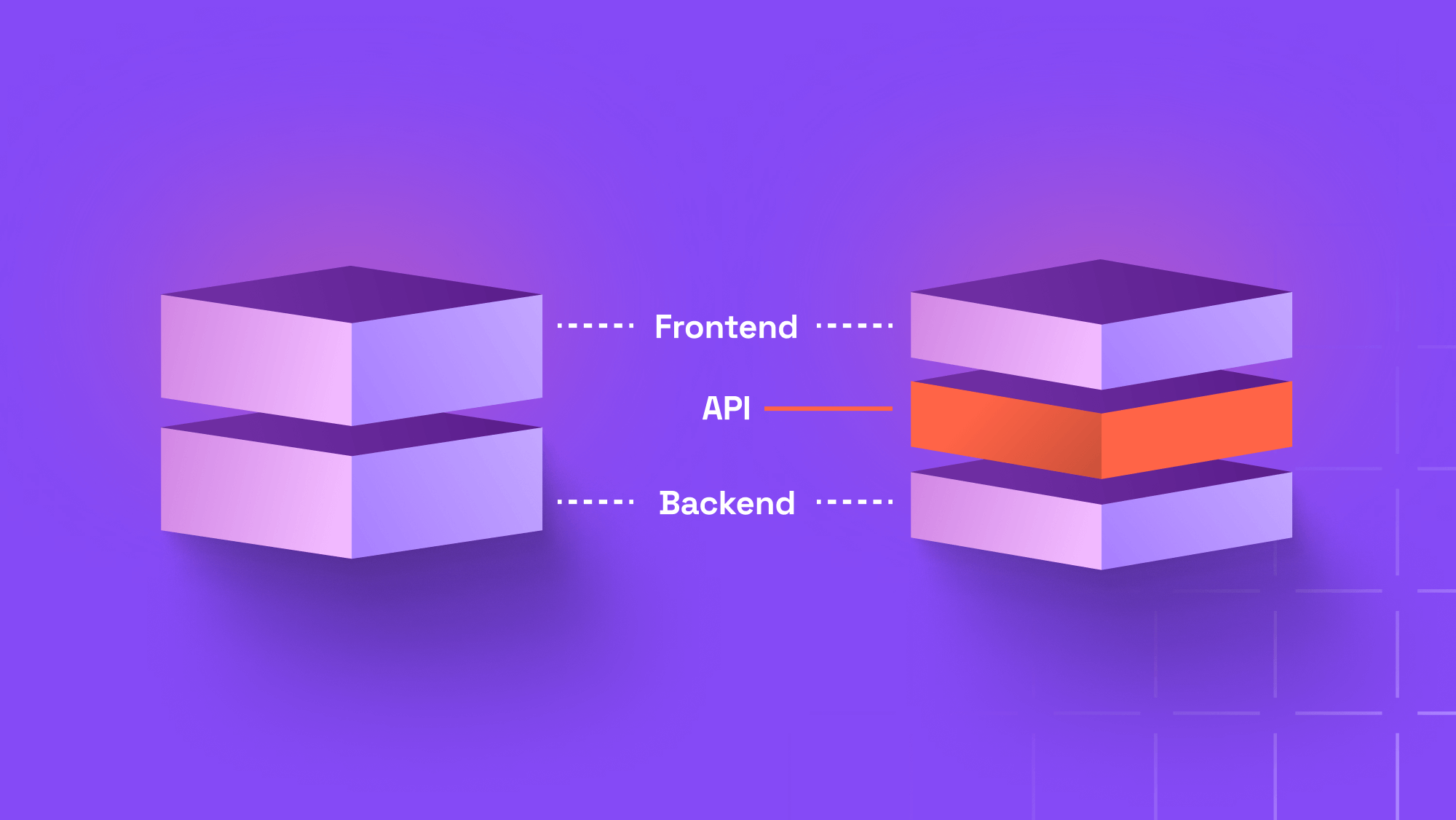
Headless commerce is an eCommerce solution that decouples the front-end from the back-end of an online store.
Simply put, the “head” is the front-end portion of your website, i.e., what the user sees and interacts with. This head is separated from your back-end portion, i.e., checkout, payments, subscriptions, and others.
Headless platforms let you plug your entire back-end system into the front-end system of your choice. The two systems work independently without impacting each other.
You then get a headless solution that enables you to deliver a better user experience and gain more flexibility.
Internet users consume content through numerous customer touchpoints. You should make your content available on multiple channels, from social to mobile to IoT. That is possible with a headless commerce solution.
Traditional eCommerce platforms don’t offer the flexibility you need. Headless solutions allow you to decouple your eCommerce data from one touchpoint to display across different channels.
You store that data in a headless CMS and then choose the heads (touchpoints) to display it. It helps you deliver omnichannel experiences.
If eCommerce stores want to thrive, they must offer their products or services on multiple channels. However, this requires a team of experienced developers, which can be expensive for some businesses.
How can you adopt an omnichannel approach without spending too much? You need a headless content management system and a headless solution like TeleportHQ.
But how does headless eCommerce make this happen? Let’s find out.
How does headless commerce work?

Image source: Dynamic Yield
A headless eCommerce platform leverages an application programming interface (API) to deliver your content. The API is a software intermediary that enables the front-end and back-end to communicate.
A headless system passes API requests from the front-end to the back-end whenever a customer interacts with your online store.
For instance, a customer purchases a product from an eCommerce brand on their smartphone. The presentation layer, i.e., the user interface, triggers an API call which is then sent to the application layer, i.e., an order management system.
The application layer acknowledges the request and processes the customer’s order. It then communicates this to the presentation layer. As a result, the customer sees the order status.
This process is the same in all headless storefronts regardless of whether the customer uses a smartphone or computer to access them. A headless commerce system registers every API request and ensures its back-end interacts with them.
The front-end portion of your headless site only displays the necessary information to the customer. It doesn’t show what happens in the back. The way that information is displayed depends on the chosen channel and its layout.
Therefore, it’s safe to say that headless technology provides flexibility and omnichannel opportunities to eCommerce brands.
Headless eCommerce stats in 2022
Headless eCommerce platforms like TeleportHQ help businesses make easy-to-use websites that meet consumer expectations and improve customer experience. It’s no wonder that more and more companies want to leverage headless commerce.
These statistics show the state of headless solutions in 2022:
- 61% of retailers say they either implemented headless commerce or plan to
- 62% of companies agree that headless eCommerce can significantly increase engagement and conversions
- 92% of businesses think it’s easier to deliver a powerful digital experience with headless commerce platforms
- 68% of companies that want to go headless would use the services of headless eCommerce platforms
- Headless technologies have raised more than $1.65 billion in funding
Having native mobile apps, being present on social media, and using a traditional eCommerce platform is not enough. You must leverage headless commerce to expand your footprint across multiple customer touchpoints.
While we’re at it, let’s see the difference between traditional and headless commerce platforms.
Traditional eCommerce platforms vs. headless eCommerce platforms

Image source: Net Solutions
Businesses can choose between headless and traditional eCommerce platforms. What is the difference between the two?
The traditional eCommerce model, also known as monolithic, is an all-in-one solution. The website’s back-end and front-end are linked together. Any change you make on the back-end will reflect on the front-end.
For example, a developer might edit a design element on the presentation layer, i.e., front-end. Although everything seems fine initially, they realize that the back-end is not operating properly. The reason might be that the change broke a vital back-end function like payment processing.
The headless architecture, however, separates the back-end from the front-end. Developers can modify the front-end without worrying that the entire website will crash. Application programming interfaces relay any code update, which doesn’t impact the front-end.
This main difference makes it easy to see why headless commerce has become popular. Let’s check out other drawbacks of traditional solutions.
The drawbacks of a traditional eCommerce platform
Should you use a traditional or headless commerce platform? The choice depends on your business and its needs. Consider the cons of the traditional eCommerce model before making a decision:
- Customization is limited – adding customization to a traditional eCommerce site requires workarounds and testing. You want to ensure nothing breaks because of a tweak. On the other hand, the headless architecture comes with limitless customization options.
- No option to create a rich customer experience – consumers demand personalization. It creates a unique customer experience that brings them closer to your brand. Traditional commerce can’t improve personalization because its front-end themes usually have limitations.
- Difficult to integrate new software – companies release new software all the time, but you won’t benefit from them easily if you use traditional commerce. Developers can find workarounds to integrate new tools, but this is time-consuming.
- Problems with optimization – the monolithic architecture is rigid. It makes it challenging to optimize your website for various devices. When customers use different devices, slow loading times, missing buttons, and distorted drop-down menus occur. As a result, consumers won’t return because of a bad user experience.
Why should you use a headless eCommerce platform? Find the answer in the next section.
4 benefits of headless eCommerce
The headless commerce architecture has four main benefits:
- Flexibility
- Customization
- Personalization
- Speed
We’ll explain each of them below.
Flexibility
As previously mentioned, the front-end and back-end are decoupled in headless commerce. It means developers can make changes and tweaks without disrupting the entire website. Other departments can also update content without any issues.
For instance, marketing teams might want to launch a promotional campaign without the developers’ help. They can do that independently as headless eCommerce doesn’t require complete system reconfiguration.
Your marketing team can update content or banners without relying on the IT team. Infinite flexibility is the beauty of headless eCommerce. Adding another checkout flow or a new subscription plan is easy when you rely on the decoupled architecture.
Customization
Headless commerce enables brands to have a decoupled approach to integrations. You can easily add new software and feature that will improve your online store.
The system’s main competitive advantage is choosing which integration to implement. A headless commerce platform doesn’t force you to buy all tools it supports. You get to choose which software your business needs.
Personalization
You can experiment with personalization without slowing down your online store. For instance, you can launch features that improve personalization in the back-end. It won’t disrupt customers who are buying products on the front end.
While the website works properly, you can test new methods to create a personalized customer experience. You can decide to personalize the content based on demographics or search history.
Headless commerce strives to create a personalized shopping and browsing experience across multiple channels. A traditional CMS like WordPress limits your personalization capabilities, while a headless CMS provides more flexibility.
It supports content personalization by
- Separating your content from the back-end
- Making content reusable across different channels
- Streamlining content localization
- Integrating with other tools
According to a survey, 72% of customers say they only engage with content tailored to their interests. Don’t treat them like they are every other shopper. Use headless commerce to personalize their experience.
Speed
User experience also depends on the speed of your website. Customers who wait too long for your online store to load will take their business elsewhere.
Fast loading times create a seamless shopping experience. Not to mention they also affect your ranking on search engines.
You don’t have to worry about the speed with a headless eCommerce platform. This technology leverages APIs to deliver content on any device. Your content reaches customers faster than on a traditional commerce platform.
Our platform, TeleportHQ, enables developers to reap the benefits of headless commerce. We offer a powerful visual builder to make and launch your headless website quickly. You can build an eye-catching website and create UI elements that set you apart.
You can leverage the advantages of headless technology! Try TeleportHQ now.
3 limitations of headless eCommerce
You have to consider the disadvantages of headless eCommerce platforms as well. Let’s discuss some of them:
- Complexity – if you launch a headless website, you’ll be responsible for its infrastructure. It can be more complex compared to a traditional website. You can make the process easier by using a headless eCommerce platform like TeleportHQ.
- Potential additional costs – the front-end and back-end are separated, which means you can incur additional costs. Each part of your website requires hosting and maintenance, increasing operational costs.
- Limited integration – you need to implement integrations so that your headless website can work properly. Some platforms already support decoupled websites, but your choice is limited. However, more companies plan to adopt headless technology to resolve this issue.
If you ask us, the benefits of a headless eCommerce platform overshadow its disadvantages. Ultimately, you should consider whether headless commerce works for your business. If it does, you must know how to choose the right headless eCommerce platform.
We have some tips for you.
3 tips for choosing a headless eCommerce platform
Don’t invest in the first headless eCommerce platform you find. You should consider your options carefully because your online stores depend on them.
We’ve compiled three tips to help you choose a headless commerce platform more easily. Let’s have a look.
Determine your goals
The first step is to decide which goals you want to achieve with a decoupled website. It can help you when evaluating your options.
What do you expect from your headless eCommerce solution? Businesses usually go headless because they can’t achieve their store management and content presentation goals with the existing tools.
For instance, they have limited content functionality or not enough plugins. These limitations encourage them to use a headless platform.
You should also consider what a decoupled system can bring to your business. Do you want to launch marketing campaigns differently? Or do you want to speed up any change you make to your storefront?
Make a list of your goals and see how a headless eCommerce platform fits in that picture.
Consider the costs
It helps if a company agrees on a budget for a headless platform. That way, you can determine whether a provider can fulfill all your needs for the amount of money you are willing to set aside. If they can’t, you might want to re-evaluate the budget.
We suggest you look for platforms that offer various pricing models. You should also have the option to pay per month or year. If you need more functionalities, you can always upgrade your plan.
For instance, TeleportHQ offers a free and Professional plan. Our pricing is transparent and flexible, so you won’t have to worry about additional costs. Check out the pricing here!
Ensure you have support
It’s crucial to have constant support from your chosen headless eCommerce platform. Bear this in mind when selecting your go-to tool.
The support team will be there for you every step of the way. They will help you during the initial stages of making sense of their platform. The team can send you starter templates, help you with testing and answer any questions you might have.
If anything goes wrong, you will have someone to rely on. It helps if they have technical documentation as well. Your developer will appreciate that.
In short, look for a vendor who will listen to your feedback and help you achieve your goals. You’ll improve your eCommerce experience when you have a trusted partner next to you.
Follow the above tips to choose the right headless commerce platform. We’ll review the best headless eCommerce platforms in the next section if you need some recommendations.
The 5 best headless eCommerce platforms for your next project
It’s difficult to commit to one solution. That’s why we’ve prepared a list of the best headless eCommerce platforms you can use in 2022.
TeleportHQ

TeleportHQ is a front-end platform perfect for web designers and web developers who create and launch websites. Users can also make headless online stores to improve their eCommerce business.
You can create your storefront UI’s easily thanks to our features like AI-powered website builder and website templates. Our drag-and-drop editor ensures your team makes visually appealing storefronts in just a few clicks.
TeleportHQ also acts as a collaboration environment, enabling your team to build in real-time. The web development is that much simpler and more seamless with our platform.
TeleportHQ features
TeleportHQ stands out because of the following features:
- Headless content modeling capabilities
- Static website templates
- AI-powered website builder
- Project-sharing options
- Advanced customization tools
- Drag-and-drop React UI visual builder
- Technical SEO features
TeleportHQ customer support
TeleportHQ has a community on Discord where you can ask questions, join groups and get help. The platform’s customer support is also available via chat and email. Paying customers receive dedicated customer support and an account manager.
TeleportHQ pricing
Available pricing plans include
- Free plan – you can invite unlimited collaborators to work in real-time. This plan comes with free ready-made templates and code exports. There is also basic hosting included.
- Professional plan (€15/editor/month) – this plan includes all features that come with the Free plan. On top of that, you get unlimited projects, dedicated customer support, and the option to upload videos. You can use professional hosting, which includes publishing on three custom domains.
TeleportHQ pros
The following advantages set TeleportHQ apart from competitors:
- AI-powered features
- Javascript frameworks export
- Machine learning to improve code generation
- One-click code generation
TeleportHQ cons
The platform’s disadvantages are:
- Some elements appear too tiny in the tool
- Our GitHub community isn’t that active
Magento
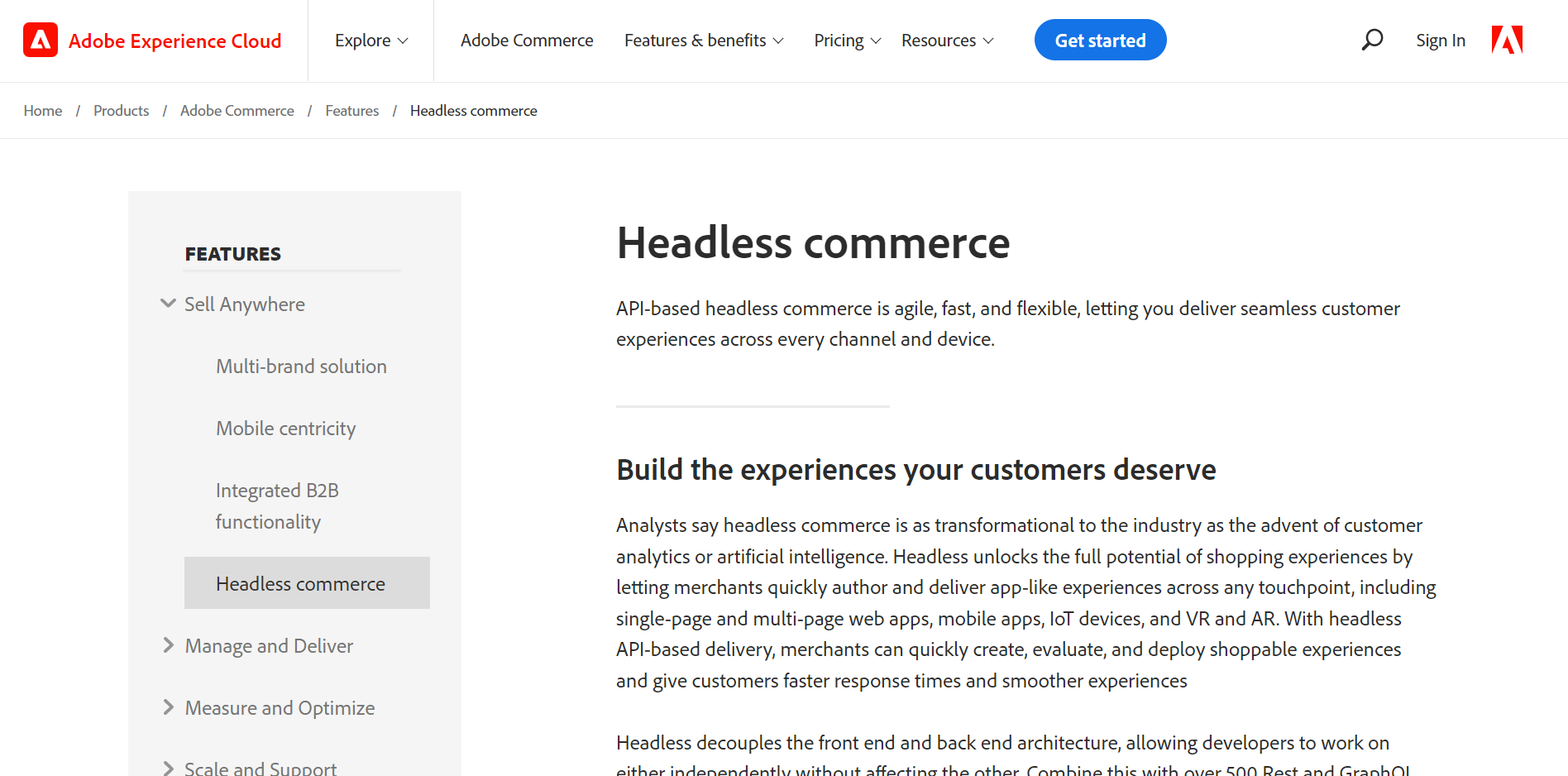
Magento is an eCommerce platform for small businesses that is now part of the Adobe Experience Cloud. Developers can enjoy a flexible store creation process with this tool.
The platform enables developers to create API-based headless online stores. Customers can access those stores across various channels. Its APIs ensure you build a customizable storefront experience.
Magento features
The main features are:
- Order management
- Catalog management
- SEO features
- Payment modes
Magento customer support
Magento customer support is available via phone and email. Customers can also submit a ticket to get help.
Magento pricing
The company offers a custom plan depending on a business's needs.
Magento pros
The Magento advantages are
- Flexibility and customization
- Omnichannel support
- Advanced features
Magento cons
As for the downsides, users usually complain about
- It’s not user-friendly
- Complex headless CMS architecture
- High cost of development
Snipcart
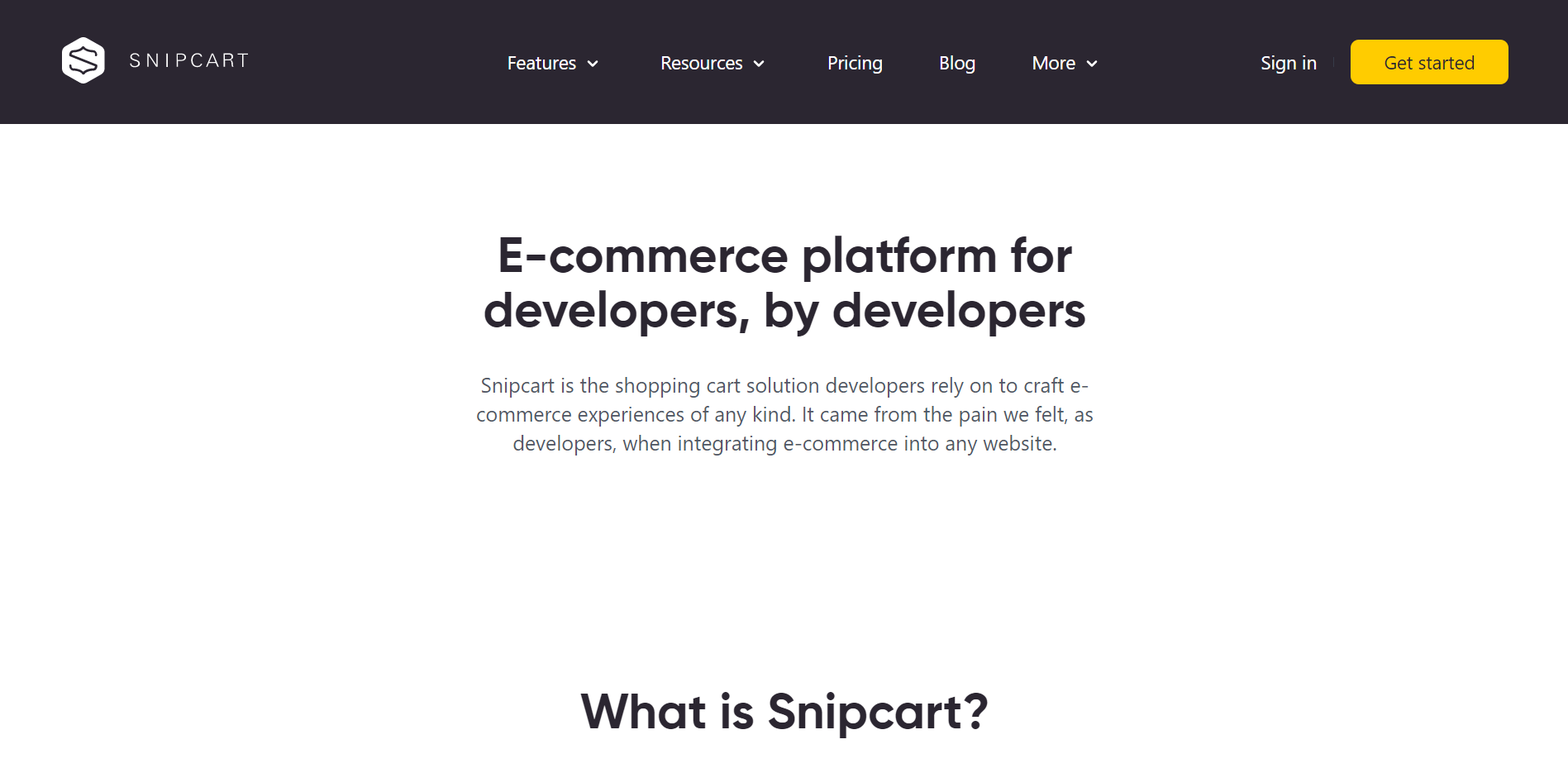
Snipcart is an eCommerce solution enabling you to add a cart and check out on any website or web app. You can integrate the tool into your CMS, such as WordPress. From there on, you can manage orders and discounts and monitor the entire online shopping process.
Snipcart features
Here are the essential Snipcart features:
- Customizable shopping cart
- Custom payment gateway
- Unlimited domains
Snipcart customer support
The platform has a dedicated support page that every customer can access. Another option is to contact the customer service representatives via email.
Snipcart pricing
The platform takes 2% of a company’s total monthly sales.
Snipcart pros
The pros include:
- Advanced inventory management
- Various marketing and CRO options like product discounts and pop-ups
- eCommerce integration
- Quick setup
Snipcart cons
Although a good eCommerce solution, Snipcart comes with some drawbacks as well. You should consider them before choosing your go-to headless eCommerce platform. The platform’s users complain about:
- Dynamic pricing issues
- UI that needs improvement
- It doesn’t have an integrated site builder
Salesforce Commerce Cloud
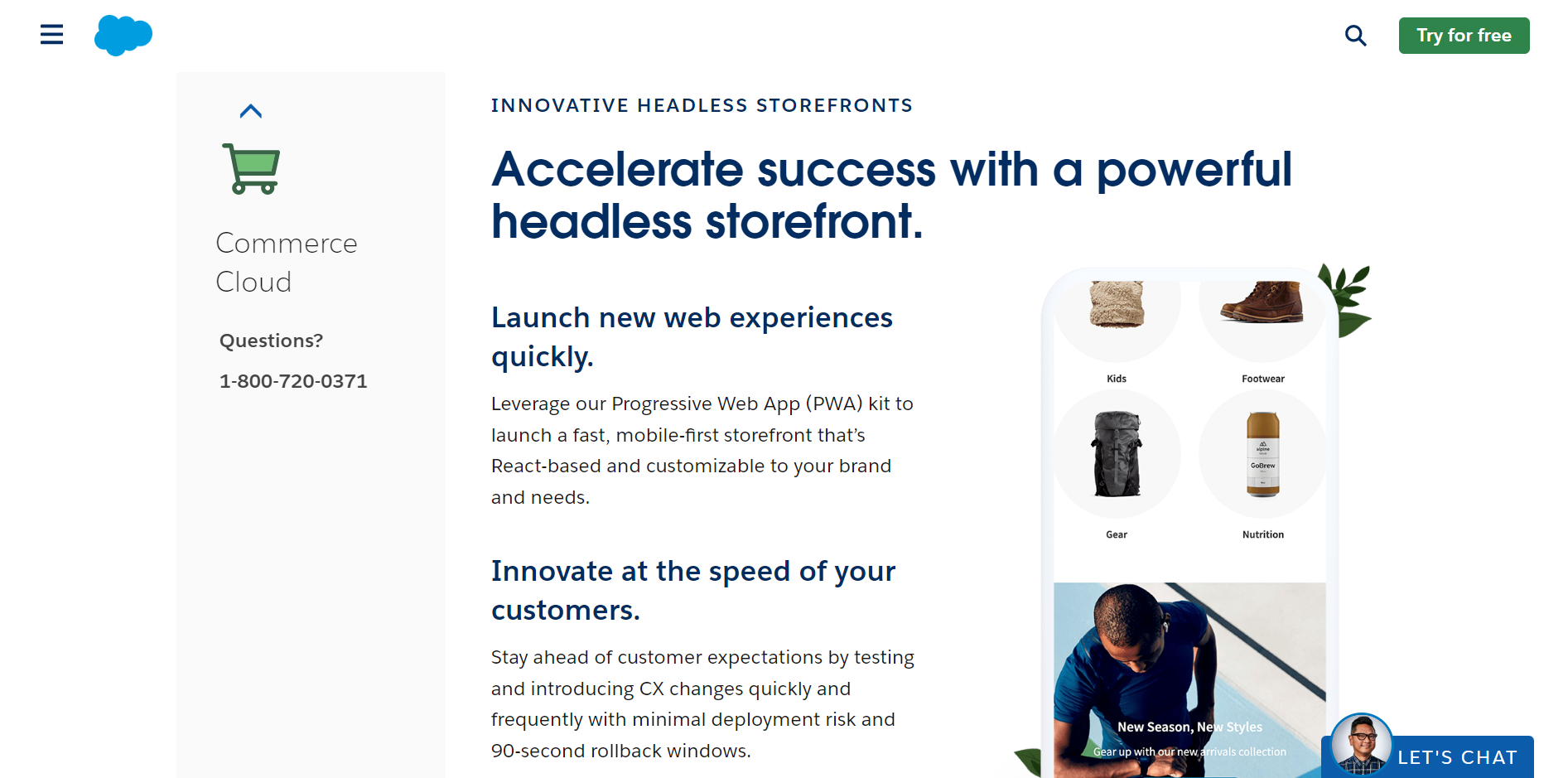
Salesforce Commerce Cloud is a cloud-based headless commerce platform. It comes with configurable APIs to offer flexibility and creative freedom to developers building online stores.
The tool is a part of Salesforce. You can use the Salesforce library of integrations to improve your online shopping experience further.
Bear in mind that the tool isn’t as user-friendly. It comes with many APIs, so it may take longer than usual to get used to it.
Salesforce Commerce Cloud features
The following features stand out:
- Order management
- Integration with platforms like Salesforce Digital 360
- Numerous commerce APIs to streamline the store creation process
Salesforce Commerce Cloud customer support
Paying customers can get support via phone and live chat. There is also the option to submit a support case through their helpdesk.
Salesforce Commerce Cloud pricing
The pricing is available upon request.
Salesforce Commerce Cloud pros
Users praise these aspects of Salesforce Commerce Cloud:
- Scalability
- Mobile optimization
- Intelligence predictive technology
Salesforce Commerce Cloud cons
Before choosing Salesforce Commerce Cloud, you should go over its cons:
- Not user-friendly
- Unpredictable costs
- Limited customization options
Commercetools
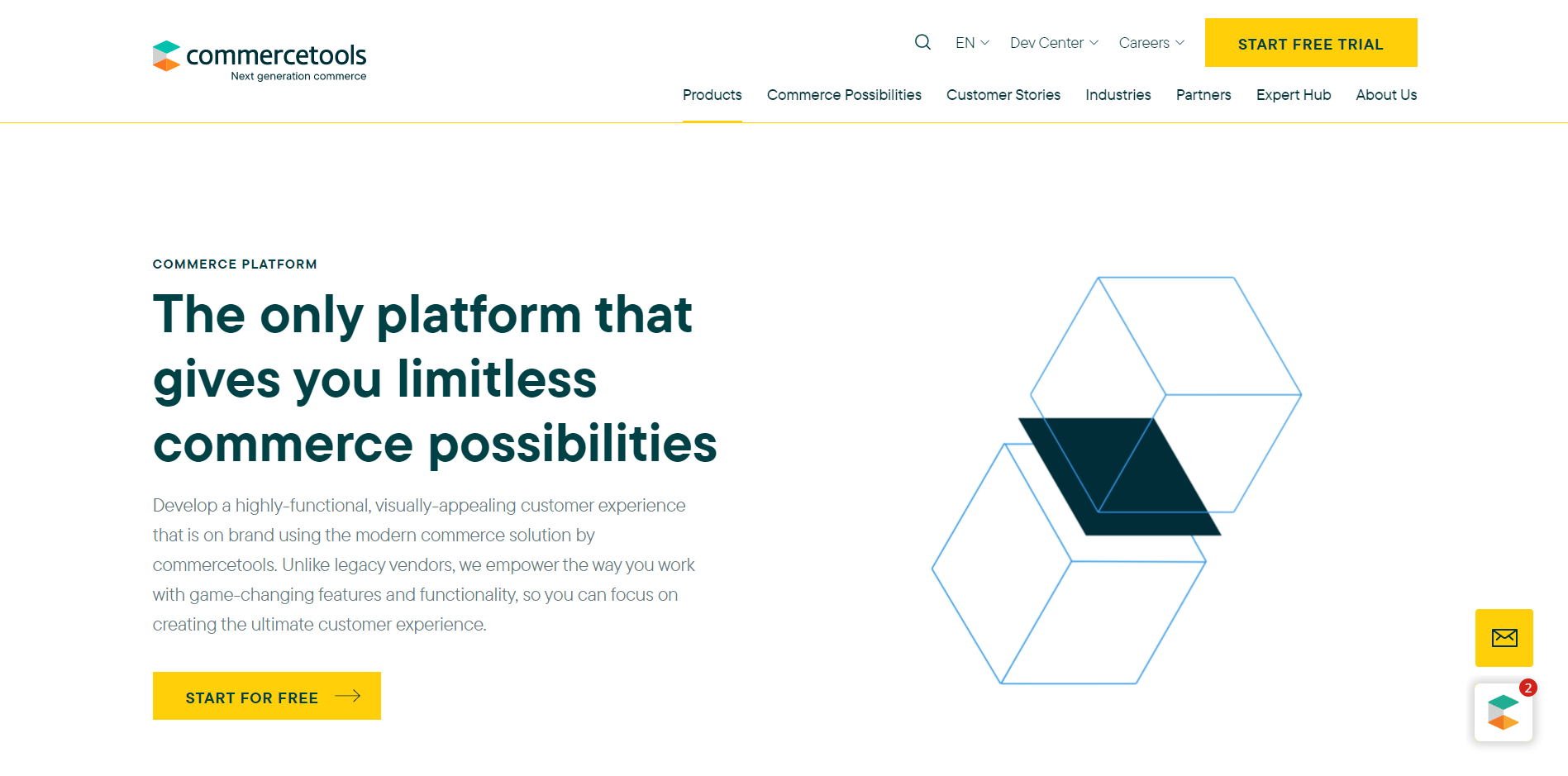
Commercetools is an eCommerce platform that helps companies develop visually appealing customer experiences. This API-first headless solution is good for creating a decoupled environment that is available across multiple devices.
You can benefit from features like catalog management and a unified cart if you have an eCommerce business. However, Commercetools can be challenging to learn. You must code and integrate some features to get the most out of the tool.
Commercetools features
- Headless platform APIs
- Order management
- Extensive APIs with GraphQL coverage
Commercetools customer support
Customer support is available via chat and contact form on their website.
Commercetools pricing
The pricing is available upon request, but the tool offers a 60-day free trial.
Commercetools pros
Its advantages are
- Scalability
- Easy to add new customer touchpoints
Commercetools cons
- It needs more built-in features to ensure an online store runs smoothly
- Not suitable for those without any technical know-how
Headless eCommerce platforms: A short overview
We examined some of the best headless eCommerce platforms available. Choose the tool that can help you achieve your eCommerce goals. If you need assistance, look at our comparison table that gives an overview of all the platforms.
Headless eCommerce: Wrapping up
Higher personalization and greater speed are the two main advantages of headless eCommerce. Companies that want to offer better user experiences need headless commerce platforms to avoid website crashes and slow loading times.
Your go-to eCommerce solution should help you build and launch visually appealing websites in just a few clicks. It should support headless technologies to take your online store to the next level. That solution is TeleportHQ!
Arm your developers with our headless platform today!
Headless eCommerce: FAQ
We have compiled a list of the most frequently asked questions about headless eCommerce. You can find the answers below.
What does headless mean in eCommerce?
In eCommerce, headless refers to separating a website’s front-end from its back-end. As the two systems aren’t connected, you can make changes that won’t negatively impact one of the systems.
What is an example of headless commerce?
An example of headless commerce is a platform like TeleportHQ, Magento, and Snipcart.
What is the advantage of headless eCommerce?
The advantages of headless eCommerce are:
- Greater flexibility
- Unlimited customization
- Better personalization
- Greater speed
Is headless CMS good for eCommerce?
Headless commerce brings advantages like flexibility and unlimited customization to online businesses. It ensures companies deliver unique customer experiences.


